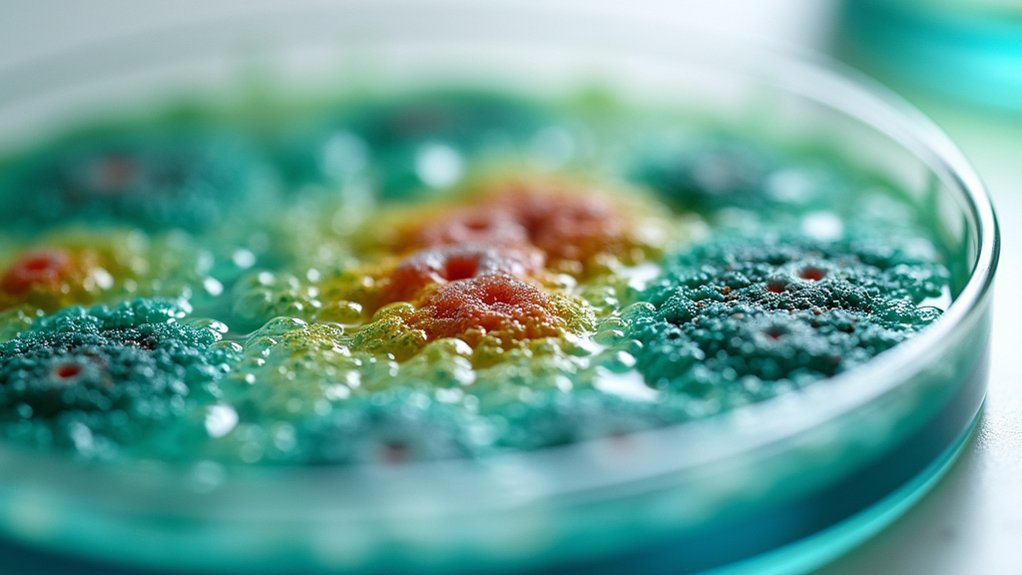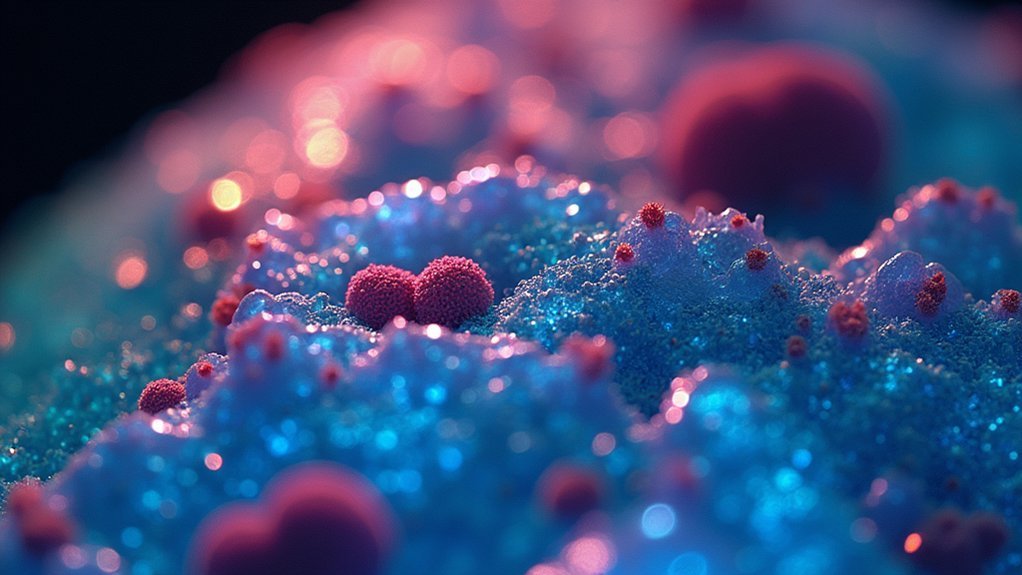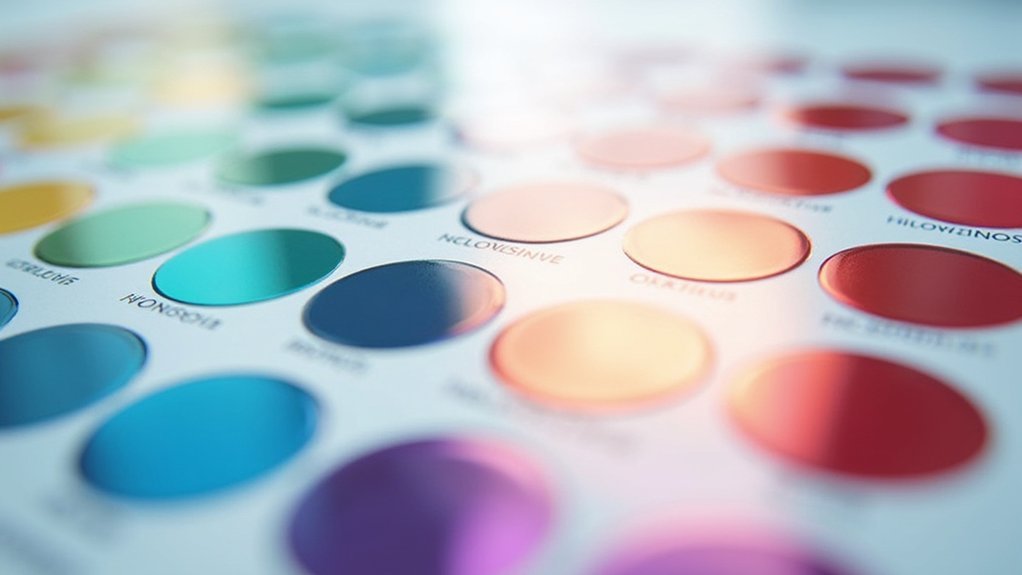Lab images show true colors through the LAB color space, which separates luminance from color information, capturing subtle hues that RGB might miss. You’ll get more accurate results with proper calibration techniques, standardized color checkers, and quality illumination sources like True Color LED technology. Device-independent LAB processing guarantees consistent reproduction across different media while enabling precise adjustments without distorting other image qualities. Explore how these elements work together to transform your microscopy workflow and diagnostic confidence.
What Makes Lab Images Show True Colors?

LAB’s broader color gamut captures subtle hues that RGB might miss, representing colors your eyes naturally detect.
This expanded range prevents clipping and posterization that can occur in RGB’s narrower space. When you’re fine-tuning images, especially for skin tones, LAB’s independent control of luminance and chromaticity enables true Color Rendering that maintains the integrity of original colors.
You’ll notice the difference particularly when making precise adjustments—LAB preserves color relationships and natural appearance while allowing targeted enhancements to specific color ranges.
The Science Behind LAB Color Space
The science underpinning LAB color space reveals why it delivers such exceptional color accuracy. Unlike device-dependent models, LAB is designed around human perception, separating luminance (L) from color information (A and B channels). This separation allows you to make precise color adjustments without affecting brightness.
LAB color space mirrors human vision, separating light from color for unparalleled precision in digital image editing.
Based on CIE colorimetry principles, LAB provides a mathematical framework that guarantees consistent color reproduction across different devices—a critical component of effective color management.
You’ll notice LAB captures a broader gamut than RGB, preserving vivid hues and subtle tonal variations that might otherwise be lost.
When the A channel measures green-to-red shifts and the B channel tracks blue-to-yellow changes, you’re working with a system that mirrors how your eyes actually perceive color differences, resulting in truer visual representations.
Evolution of Color Rendering in Digital Microscopy

Digital microscopy has traveled a remarkable path from early grayscale imaging limitations to today’s sophisticated full-spectrum visualization systems.
You’ll find that modern digital calibration technologies now compensate for illumination variations, ensuring consistent color representation across different microscopes and lighting conditions.
Advanced spectral analysis tools have further revolutionized the field, allowing you to distinguish subtle tissue variations that were previously indiscernible with conventional imaging methods.
Early Grayscale Limitations
While revolutionary in their time, early microscopy imaging systems suffered from significant diagnostic constraints due to their grayscale-only capabilities. You’d find yourself struggling to differentiate between tissue types as similar structures often reflected light in nearly identical grayscale values, creating frustrating ambiguity.
Without color context, these limitations directly impacted your ability to:
- Identify cellular morphology accurately, as subtle differences weren’t visible in grayscale
- Distinguish between similarly reflecting materials that would appear distinct in color
- Interpret staining patterns essential for pathological diagnosis
The shift from grayscale to color imaging transformed microscopy’s diagnostic potential.
Today’s digital systems with true color LED illumination provide consistent color rendering across various intensities, allowing you to make more precise evaluations of tissue conditions and disease states.
Digital Calibration Systems
Achieving reliable color reproduction became possible through sophisticated digital calibration systems that revolutionized microscopy imaging.
You’ll find these systems now compensate for spectral discrepancies between light sources and camera sensors, ensuring images faithfully represent actual specimens.
When you’re examining histological samples, True Color LEDs maintain consistent color rendering regardless of intensity—unlike traditional halogen lamps that shift colors as brightness changes.
Modern calibration protocols employ color correction filters and smart management systems to refine spectral output for precise stain reproduction.
The integration of chromaticity diagrams has standardized color rendering metrics, making it easier to compare different illumination sources.
These continuous advancements aren’t just technical improvements—they’re essential tools for pathologists and researchers who rely on accurate color representation for dependable clinical and scientific observations.
Spectral Analysis Advances
Revolutionizing the field of microscopic imaging, recent spectral analysis advances have transformed how we perceive and interpret cellular structures.
You’ll notice dramatically improved color accuracy in your microscopy work, thanks to sophisticated spectral technologies that capture true specimen colors without distortion.
True Color LED light sources now rival traditional halogen lamps, providing consistent spectral uniformity for your samples. These innovations guarantee you’re seeing genuine tissue characteristics, not color artifacts.
Key improvements include:
- IR cut filters that eliminate infrared interference
- Smart color management systems that maintain consistency across lighting conditions
- Enhanced digital processing algorithms specifically calibrated for histological analysis
When you’re differentiating critical tissue structures, these spectral analysis enhancements deliver the color accuracy necessary for reliable diagnoses and research outcomes—preventing the potentially dangerous misinterpretations that can result from color shifting.
Understanding Color Models: RGB vs. LAB

When you’re working with digital imagery, understanding how RGB and LAB color models represent visual information fundamentally changes your results.
RGB combines primary colors additively for screens, while LAB separates luminance from color information, making it device-independent and closer to human visual perception.
You’ll notice LAB’s expanded gamut captures subtle color nuances that RGB might miss, particularly in scientific imaging where accurate color reproduction is critical.
Color Representation Fundamentals
Although we often take digital colors for granted, understanding the difference between color models is essential for accurate image reproduction. When you view an RGB image on your screen, you’re seeing a device-dependent color space that combines red, green, and blue light at varying intensities to create colors.
LAB color space offers significant advantages:
- It’s device-independent, ensuring consistent color appearance across different screens and printing methods.
- It separates lightness (L) from color (A and B), allowing for more precise adjustments without affecting other qualities.
- It encompasses a wider gamut than RGB, capturing colors your monitor can’t display but your eye can perceive.
This fundamental difference is why LAB excels at preserving true colors when converting between digital and physical media.
Device-Independent Color Spaces
Unlike the RGB model that depends on specific device characteristics, LAB color space offers a truly device-independent approach to color representation.
When you work with LAB, you’re using a model based on human visual perception rather than hardware limitations, ensuring true color consistency across different monitors, cameras, and printers.
The separation of lightness (L) from color information (A and B channels) allows you to make precise adjustments without disrupting other aspects of your image.
You’ll find that LAB captures a wider color gamut than RGB, revealing subtle tones that might otherwise be lost.
This device-independent nature makes LAB invaluable when accuracy matters—whether you’re preparing professional photography, calibrating displays, or ensuring brand colors remain consistent across all media platforms.
Visual Perception Differences
Our human eyes perceive colors differently than how digital devices represent them, which explains why RGB and LAB color models diverge so significantly in their approach. LAB color space was specifically designed to mimic human visual perception of the entire visual spectrum, unlike RGB which was created for digital displays.
When you work with images, these perception differences become critical:
- Your eyes can detect subtle color variations that RGB often fails to capture, while LAB preserves these nuances through its wider gamut.
- You’ll notice LAB separates brightness (luminance) from color information, matching how your visual system processes what you see.
- Your perception of color remains consistent across different lighting conditions, which LAB accommodates better than device-dependent RGB.
Separating Luminance From Chrominance: the LAB Advantage

When you’re aiming for true color representation in your images, LAB mode offers a powerful advantage through its fundamental separation of brightness and color information.
Unlike other color models, LAB isolates luminance (L channel) from chrominance (A and B channels), allowing you to make precise adjustments to one without affecting the other.
This separation enables you to enhance tonal contrast in the L channel while preserving color integrity.
You’ll notice fewer posterization issues during editing, as LAB’s larger color space accommodates a wider range of hues than RGB or CMYK.
When correcting color casts or imbalances, you can work directly with the chrominance channels without disrupting brightness values.
The result? More accurate colors and smoother shifts in your final images, maintaining the natural appearance that mirrors human visual perception.
Color Gamut and Accuracy in Microscope Imaging
Faithful representation of specimens under microscopes depends critically on the color gamut capabilities of your imaging system.
Accurate specimen visualization hinges entirely on the color reproduction range of your microscope’s imaging technology.
When you’re analyzing histological samples, accurate color rendering makes the difference between precise and questionable diagnoses. Traditional halogen lamps have been the gold standard, but modern True Color LED sources now offer comparable performance with added benefits.
For ideal color reproduction in your microscopy work, consider:
- Selecting high-quality LED illumination that mimics halogen’s spectral characteristics
- Implementing advanced color management systems in your digital cameras
- Ensuring your light source maintains spectral uniformity across all intensity levels
Color shifts between illumination types can greatly impact your analysis.
Calibration Techniques for True Color Representation

To achieve true color representation in microscopy imaging, proper calibration serves as the cornerstone of reliable visual data.
You’ll need to incorporate standardized color checkers as reference targets to guarantee your imaging system captures colors accurately.
Regular calibration using spectrophotometers helps maintain consistency across different devices and lighting conditions.
Implement ICC profiles to adjust color spaces, guaranteeing your monitor displays match what your camera or scanner captures.
Don’t overlook white balance adjustments for your specific lighting environment—these corrections prevent color temperature variations that can distort your specimens’ true colors.
For precise control, incorporate LAB mode into your color management workflow, which separates color information from luminance data, giving you enhanced control over color accuracy in your microscopy images.
Digital Processing Workflows for Authentic Lab Images
Maintaining authentic colors during digital processing requires strategic workflows that preserve the integrity of your original specimens. Converting your images to LAB mode gives you powerful control across the visible spectrum while protecting color fidelity. LAB’s separation of lightness from color information allows for precise adjustments that RGB processing simply can’t match.
LAB mode empowers precision color preservation where RGB falls short, maintaining authenticity across your digital workflow.
To guarantee your lab images display true colors:
- Monitor your histogram distribution in the a and b channels to prevent posterization that can distort color perception.
- Make color contrast adjustments in LAB mode to enhance details without affecting neutral tones.
- Regularly test your image quality during processing shifts between color spaces.
Remember to pay special attention to skin tones by keeping aStar and bStar values appropriately balanced.
Your image processing workflow should include continuous quality checks to maintain authenticity throughout.
Hardware Considerations for Optimal Color Fidelity
When capturing lab images with true color representation, you’ll need to take into account your microscope’s illumination source as different light types can dramatically affect color rendering.
Your imaging sensor’s spectrum calibration must match the wavelengths of interest to guarantee accurate color reproduction throughout the visible spectrum.
Properly matching these hardware components creates a foundation for color fidelity that software adjustments alone can’t compensate for.
Microscope Illumination Sources
The heart of reliable microscope color reproduction lies in the illumination source you select for your imaging system.
While halogen lamps have traditionally been the gold standard due to their excellent rendering of white light across the full spectrum, LED technology has evolved to offer comparable performance with added benefits.
When evaluating illumination options for your lab, consider:
- True Color LED technology mimics halogen’s natural spectral distribution, avoiding the red light deficiencies common in generic LEDs
- Chromaticity measurements reveal how closely an illumination source maintains color accuracy at varying intensities
- Color correction filters can help balance LED output but may not match halogen’s inherent color quality
The illumination source you choose directly impacts your samples’ color fidelity, with advanced LED systems now providing halogen-comparable accuracy while offering greater energy efficiency and longevity.
Sensor Spectrum Calibration
Three critical factors determine if your microscopy images display true colors – and your sensor’s spectral response tops the list. Your camera’s CCD or CMOS sensor doesn’t uniformly capture all wavelengths, particularly struggling beyond 700 nm in the infrared range.
To achieve accurate color reproduction, you’ll need proper sensor spectrum calibration. Start by using standardized color calibration targets during image capture, which provide essential reference points for adjusting your color profiles.
Regular calibration against these targets helps prevent metameric failures, ensuring consistent results across different lighting environments.
Don’t overlook white balance adjustments and color correction filters – these techniques notably enhance your sensor’s ability to faithfully represent specimens.
Evaluating Color Accuracy in Histological Samples
Accurate color reproduction stands at the forefront of reliable histological analysis, as pathologists depend on precise color differentiation to identify cellular structures and tissue types.
Color fidelity serves as the cornerstone of histopathology, enabling precise identification of cellular structures through accurate stain representation.
When evaluating histological images, you’ll need to take into account how light sources affect color rendering.
True Color LED illumination offers significant advantages over traditional lighting:
- Provides consistent spectral output that matches halogen lamps, reducing color shifts that can lead to misinterpretation
- Allows for more reliable visual assessment of tissue samples through improved spectral uniformity
- Enhances visibility of stained sections when combined with appropriate color correction filters
You can use chromaticity diagrams to compare different light sources’ performance when selecting ideal illumination for your histological analyses.
This evaluation guarantees your images represent tissue colors accurately, improving diagnostic reliability.
Advanced LED Illumination for True Color Microscopy
While traditional lighting systems have served microscopy for decades, advanced True Color LED illumination now delivers superior spectral consistency for precise histological analysis.
You’ll notice these systems closely mimic halogen lamps while eliminating the color shifts typically found in generic LED sources. When examining H&E or Azan trichrome stains, True Color LEDs maintain accurate visualization regardless of intensity adjustments.
This spectral uniformity guarantees what you see truly represents the sample’s actual colors.
The benefits extend beyond accuracy—you’ll reduce energy consumption and maintenance costs while maintaining high brightness levels.
When paired with smart color management in digital microscopy cameras, your imaging workflow achieves exceptional color fidelity. This technological advancement provides the reliability you need for confident diagnosis and analysis of histological samples without compromising true color representation.
Frequently Asked Questions
What Does True Color Mean in Image Processing?
True color in image processing means you’re seeing colors accurately as your eyes would perceive them. It’s achieved through precise RGB mapping that represents the full visible spectrum while minimizing color errors in rendering.
What Is the Difference Between Lab Color and CMYK?
LAB color represents all visible colors with device-independent values (lightness, a*, b*), while CMYK is device-dependent and limited to printable ink combinations. You’ll find LAB better for editing and CMYK for printing.
What Is a True Color Image in Remote Sensing?
A true color image in remote sensing shows you Earth as your eyes would see it, using visible light wavelengths mapped to RGB channels. You’ll recognize natural features with their actual colors from space.
What Determines What Colors to Use in a False Color Image?
You’ll choose colors for false color images based on what you’re highlighting—typically selecting contrasting colors for specific features like vegetation, water, or minerals to make them visually distinct and easily interpretable.
In Summary
You’ve now seen how LAB color space separates luminance from color data, delivering more accurate representations of your specimens. By upgrading your illumination technology, calibrating your equipment regularly, and implementing proper digital workflows, you’ll capture the true colors of your samples. Remember, superior color fidelity isn’t just about aesthetics—it’s essential for accurate diagnosis and research interpretation in modern microscopy.





Leave a Reply